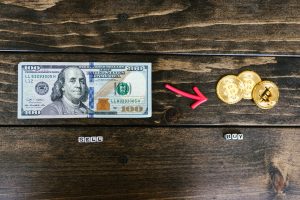The Forex market is the largest financial market in the world. It comprises buying and selling of currencies at fixed exchange rates, where one currency is traded for another. Many economic and geopolitical variables, including inflation, interest rates, political stability, and trade regulations, have an impact on a currency’s exchange rate. By accurately predicting the direction of currency prices and placing positions appropriately, traders on the forex market can earn. One example of such position is shorting the euro.
Shorting a currency involves borrowing it, selling it at the current market price, and then repurchasing it later at an expected rate (usually lower rate), thereby profiting from the difference. To short the euro simply means selling Euros and buying another currency, such as the US dollar, with the hopes of buying it back at a lower price to make a profit. Here, we will be discussing various methods used in shorting Euro.
1. Using Forex Contracts
A forex contract is a standardized agreement between two parties to purchase or sell a particular amount of a currency at a predetermined price and date in the future. Forex contracts are the most commonly used instrument in the Forex market.
This process involves choosing a Forex broker, analyzing the market, examining a trading strategy, placing a short trade, and monitoring your trade.
- Choosing a Forex Broker
You must open a forex trading account with a reputable broker who offers the euro as a trading pair in order to short the currency. There are many different forex brokers available online, but it is important to pick one that is licensed and authorized in your country. Your money is safe with a regulated broker, and the trading interface is open and honest. Moreover, search for a broker with competitive spreads, cheap commissions, and a user-friendly trading platform.
- Analysing The Market
You must conduct a market analysis and determine the variables that could have an impact on the value of the euro before you short it. To analyze the market, you can employ a variety of methods and tools, including technical analysis, and fundamental analysis. For the purpose of spotting trends and potential entry and departure locations, technical analysis involves analyzing charts and patterns. Fundamental analysis involves understanding the underlying foundations of the currency which includes evaluating economic data and news announcements. We also have Sentiment research which involves determining the state of the market through news, social media, and other sources.
- Examining A Trading Strategy
After conducting a market analysis, you must select a trading strategy that matches your trading preferences and level of risk management. You can short the euro using a variety of trading techniques, including swing trading, day trading, position trading, and scalping trading. While day trading entails opening and closing positions within a single day, swing trading requires holding a position for a few days to a few weeks. While position trading entails keeping a position for several months or even years, scalping includes making quick money from minute price changes.
- Placing A Short Trade
You must enter a short trade on the euro after selecting your trading strategy. To do this, choose the “sell” option and choose the euro as the currency pair you wish to trade in order to do this. The amount you wish to trade must then be entered, and your stop loss and take profit levels must be set. The take profit is the price at which your trade will automatically close if the market moves in your favor, whilst the stop loss is the price at which it will do so if the market moves against you. You should also take into consideration the opportunity offered by your broker, which enables you to manage a greater position with less funds.
- Monitoring Your Trade
After placing your short trade, you need to closely monitor it and, if required, modify your stop loss and take profit levels. Additionally, keep an eye out for any news or developments that might have an impact on the Euro’s value. Be ready to exit your trade if the market turns against you. To prevent big losses, it’s crucial to trade with discipline and carefully manage your risk.
2. Currency ETFs and ETNs
You can successfully short Euros without trading Forex through Exchange-Traded Funds (ETFs) and Exchange-Traded Notes (ETNs). ETFs and ETNs are financial instruments that track the performance of specific currency pairs, such as EUR/USD.
You can buy inverse Euro ETFs/ETNs that moves inversely to the Euro’s value, thereby providing another way to short the Euro.
3. Currency Futures And Options
Contracts to buy or sell a specific quantity of a currency at a predetermined price and date are known as currency futures. Currency option is simply the right, but not the responsibility, to purchase or sell a currency at a particular exchange rate before the option expires. Trading currency futures and options contracts can also provide a way to short the euro.
Conclusion
Shorting the Euro is a popular trade among Forex traders, but it requires careful analysis, and a well-planned trading strategy. By following the steps outlined above, you can successfully short the euro and potentially make profits in the Forex market.






